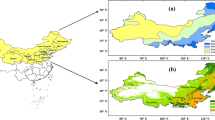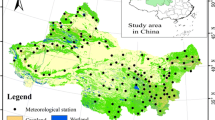Abstract
Global warming-related climate changes have significantly impacted the growth of terrestrial vegetation. Quantifying the spatiotemporal characteristic of the vegetation’s response to climate is crucial for assessing the potential impacts of climate change on vegetation. This study analyzed the spatiotemporal responses of different vegetation types across China between the normalized difference vegetation index (NDVI) that reflects vegetation activity and the standardized precipitation evapotranspiration index (SPEI) that indicates drought conditions by reflecting water conditions at different timescales. The NDVI was separated into 12 time series (one per month), and the SPEI of 12 droughts timescales was used to make the correlation. The results suggest that the response of vegetation growth to changes in the SPEI varies according to vegetation type. Specifically, positive correlations are found in arid and sub-arid environments where soil water is a primary constraining factor for plant growth, while negative correlations exist in humid environments, corresponding to regions where soil water is commonly sufficient. The results also show that negative correlations occur primarily at short timescales (1–5 months) in spring and winter and positive correlations correspond to long timescales (9–12 months) in summer. Further spatial analysis indicates that positive correlations are primarily found in northern China which is a region that has a primarily negative water balance (i.e., water deficits) while negative correlations are primarily found in southern China. The disclosed patterns of spatiotemporal responses in vegetation growth to droughts are important for impact assessments of climate change on vegetation growth.







Similar content being viewed by others
References
Barber VA, Juday GP, Finney BP (2000) Reduced growth of Alaskan white spruce in the twentieth century from temperature-induced drought stress. Nature 405:668–673
Beck HE, McVicar TR, Dijk AIJM, Schellekens J, Jeu RAM, Bruijnzeel L (2011) Global evaluation of four AVHRR-NDVI data sets: intercomparison and assessment against Landsat imagery. Remote Sens Environ 115:2547–2563
Briffa LR, Schweingruber FH, Hones PD, Osborn TJ, Shiyatov SG, Vaganov EA (1998) Reduced sensitivity of recent tree-growth to temperature at high northern latitudes. Nature 391:678–682
Chaves MM, Maroco JP, Pereira JS (2003) Understanding plant responses to drought: from genes to the whole plant. Funct Plant Biol 30:239–264
Dai A (2011) Drought under global warming: a review. Wires Clim Change 2:45–65
Dai A (2013) Increasing drought under global warming in observations and models. Nat Clim Change 3:52–58
Guehl JM, Aussenac G, Bouachorine J, Zimmermann R, Pennes JM, Ferhi A, Grieu P (1991) Sensitivity of leaf gas exchange to atmospheric drought, soil drought, and water-use efficiency in some Mediterranean Abies species. Can J For Res 21:1507–1515
Guttman NB (1998) Comparing the Palmer drought index and the standardized precipitation index. J Am Water Resour Assoc 34:113–121
Hacke UG, Sperry JS (2001) Functional and ecological xylem anatomy. Perspect Plant Ecol 4:97–115
Heim RR (2002) A review of twentieth-century drought indices used in the United States. Bull Am Meteorol. Soc 83:1149–1165
Huxman TE, Smith MD, Fay PA, Knapp AK, Shaw MR, Loik ME, Smith SD, Tissue DT, Zak JC, Weltzin JF, Pockman WT, Sala OE, Haddad BM, Harte J, Koch GW, Schwinning S, Small EE, Williams DG (2004) Convergence across biomes to a common rain-use efficiency. Nature 429:651–654
IPCC(2013) Summary for policymaker. In: Stocker TF, Qin D, Plattner GK, Tignor M, Allen SK, Boschung J, Nausels A (eds) Climate change (2013): the physical science basis. Contribution of working group I to the fifth assessment report of the intergovernmental panel on climate change
Jain SK, Keshri R, Goswami A, Sarkar A, Chaudhry A (2009) Identification of drought-vulnerable areas using NOAA AVHRR data. Int J Remote Sens 30:2653–2668
Ji L, Peters AJ (2003) Assessing vegetation response to drought in the northern Great Plains using vegetation and drought indices. Remote Sens Environ 87:85–98
Karnieli A, Agam N, Pinker RT, Anderson M, Imhoff ML, Gutman GG, Panov N, Goldberg A (2010) Use of NDVI and land surface temperature for drought assessment: merits and limitations. J Clim 23:618–633
Kogan FN (1995) Application of vegetation index and brightness temperature for drought detection. Adv Space Res 15:91–100
Liang L, Zhao S, Qin Z, He K, Chen C, Luo Y, Zhou X (2014) Drought change trend using MODIS TVDI and its relationship with climate factors in China from 2001 to 2010. J Integr Agric 13:1501–1508
López-Moreno JI, Vicente-Serrano SM, Zabalza J, Beguería S, Lorenzo-Lacruz J (2013) Hydrological response to climate variability at different time scales: a study in the Ebro basin. J Hydrol 477:175–188
Lorenzo-Lacruz J, Vicente-Serrano SM, López-Moreno JI, Beguería S, García-Ruiz JM, Cuadrat JM (2010) The impact of droughts and water management on various hydrological systems in the headwaters of the Tagus River (central Spain). J Hydrol 386:13–26
Lundholm B (1976) Adaptations in arid ecosystems. In: Rapp A, Le Houserou NH, Lundholm B (eds) Can desert encroachment be stopped? Ecological Bull. No. 24
Madrigal-González J, Zavala MA (2014) Competition and tree age modulated last century pine growth responses to high frequency of dry years in a water limited forest ecosystem. Agric For Meteorol 192–193:18–26
McKee TB, Doesken NJ, Kleist J (1993) The relationship of drought frequency and duration to time scales. In: Eighth conference on applied climatology, pp 17–22
Mendivelso HA, Canarero JJ, Gutiérrez E, Zuidema PA (2014) Time-dependent effects of climate and drought on tree growth in a Neotropical dry forest: short-term tolerance versus long-term sensitivity. Agric For Meteorol 188:13–23
Mohammat A, Wang XH, Xu XT, Peng LQ, Yang Y, Zhang XP, Myneni RB, Piao SL (2013) Drought and spring cooling induced recent decrease in vegetation growth in Inner Asia. Agric For Meteorol 178–179:21–30
Mu QZ, Zhao MS, Kimball JS, McDowell NG, Running SW (2013) A remotely sensed global terrestrial drought severity index. Bull Am Meteorol Soc 94:83–98
Palmer WC (1965) Meteorological drought U.S. Department of Commerce Weather Bureau Research Paper, pp 45–58
Piao S, Ciais P, Huang Y, Shen Z, Peng S, Li J, Zhou L, Liu H, Ma Y, Ding Y, Friedlingstein P, Liu C, Tan K, Yu Y, Zhang T, Fang J (2010) The impacts of climate change on water resources and agriculture in China. Nature 467:43–51
Potter CS, Brooks V (1998) Global analysis of empirical relations between annual climate and seasonality of NDVI. Int J Romote Sens 19:2921–2948
Rouse JW, Haas RH, Achell JA, Deering DW (1974) Monitoring the vernal advancement and retrogradation (green wave effect) of natural vegetation. NASA/GSFC type III final report. NASA, Greenbelt, MD
Santos P, Negrín AJ (1997) A comparison of the normalized difference vegetation index and rainfall for the Amazon and Northeastern Brazil. J Appl Meteorol 36:958–965
Schuur EAG (2003) Productivity and global climate revisited: the sensitivity of tropical forest growth to precipitation. Ecology 84:1165–1170
Schwinning S, Sala OE (2004) Hierarchy of responses to resource pulses in arid and semi-arid ecosystems. Oecologia 141:211–220
Son NT, Chen CF, Chen CR, Chang LY, Minh VQ (2012) Monitoring agricultural drought in the Lower Mekong Basin using MODIS NDVI and land surface temperature data. Int J Appl Earth Obs Geoinf 18:417–427
Thornthwaite CW (1948) An approach toward a rational classification of climate. Geogr Rev 38:55–94
Trenberth KE, Dai A, van der Schrier G, Jones PD, Barichivich J, Briffa KR, Sheffield J (2014) Global warming and changes in drought. Nat Clim Change 4:17–22
Tucker CJ, Pinzon JE, Brown ME (2004) Global inventory modeling and mapping studies. Global Land Cover Facility, University of Maryland, College Park, MD
Tucker CJ, Pinzon JE, Brown ME, Slayback DA, Pak EW, Mahoney R, Vermote E, Saleous NE (2005) An extended AVHRR 8-km NDVI dataset compatible with MODIS and SPOT vegetation NDVI data. Int J Remote Sens 26:4485–4498
Vicente-Serrano SM (2007) Evaluating the impact of drought using remote sensing in a Mediterranean semi-arid region. Nat Hazards 40:173–208
Vicente-Serrano SM, Beguería S, López-Moreno JI (2010) A multiscalar drought index sensitive to global warming: the standardized precipitation evapotranspiration index. J Clim 23:1696–1718
Vicente-Serrano SM, Gouveia C, Camarero JJ, Beguería S, Trigo R, López-Moreno JI, Azorín-Molina C, Pasho E, Lorenzo-Lacruz J, Revuelto J, Morán-Tejeda E, Sanchez-Lorenzo A (2013) Response of vegetation to drought time-scales across global land biomes. Proc Natl Acad Sci USA 110:52–57
Vicente-Serrano SM, Camarero JJ, Azorin-Molina C (2014) Diverse responses of forest growth to drought time-scales in the northern Hemisphere. Glob Ecol Biogeogr 23:1019–1030
Wagle P, Xiao XM, Torn MS, Cook DR, Matamala R, Fischer ML, Jin C, Dong JW, Biradar C (2014) Sensitivity of vegetation indices and gross primary production of tallgrass prairie to severe drought. Remote Sens Environ 152:1–14
Wilhite DA (1993) Drought assessment, management, and planning: theory and case studies, vol 2., Natural Resources Management and Policy SeriesKluwer, Dordrecht
Willson CJ, Manos PS, Hackson RB (2008) Hydraulic traits are influenced by phylogenetic history in the drought-resistant, invasive genus Juniperus (Cupressaceae). Am J Bot 95:299–314
Wu CY, Chen JM (2013) Diverse responses of vegetation production to interannual summer drought in North America. Int J Appl Earth Obs Geoinf 21:1–6
Yu MX, Li QF, Hayes MJ, Svoboda MD, Heim RR (2014) Are droughts becoming more frequent or severe in China based on the standardized precipitation evapotranspiration index: 1951–2010? Int J Climatol 34:545–558
Zhang XS (2007) Vegetation map of the People’s Republic of China (1:1000000) and its illustration putto press Geological Publishing House
Zhang JP, Zhang LB, Xu C, Liu WL, Qi Y, Wo X (2014) Vegetation variation of mid-subtropical forest based on MODIS NDVI data: a case study of Jinggangshan City, Jiangxi Province. Acta Ecol Sin 34:7–12
Acknowledgments
This work was supported by the National Natural Science Foundation of China (No. 41571185 and 41321001), the National Basic Research Program of China (No. 2012CB955401), the Fundamental Research Funds for the Central Universities (2015KJJCB33), and the New Century Excellent Talents in University (No. NCET-10-0251).
Author information
Authors and Affiliations
Corresponding author
Rights and permissions
About this article
Cite this article
Li, Z., Zhou, T., Zhao, X. et al. Diverse spatiotemporal responses in vegetation growth to droughts in China. Environ Earth Sci 75, 55 (2016). https://doi.org/10.1007/s12665-015-4781-0
Received:
Accepted:
Published:
DOI: https://doi.org/10.1007/s12665-015-4781-0




